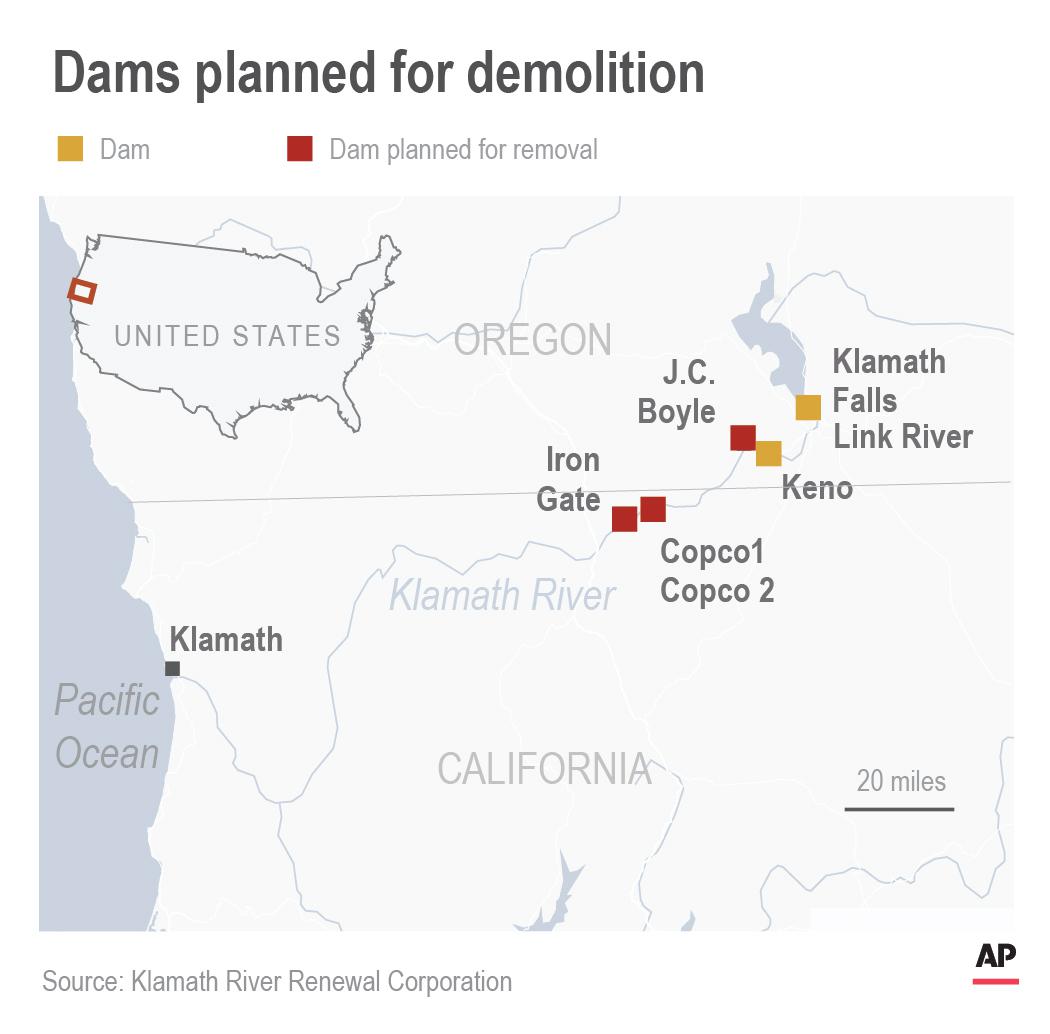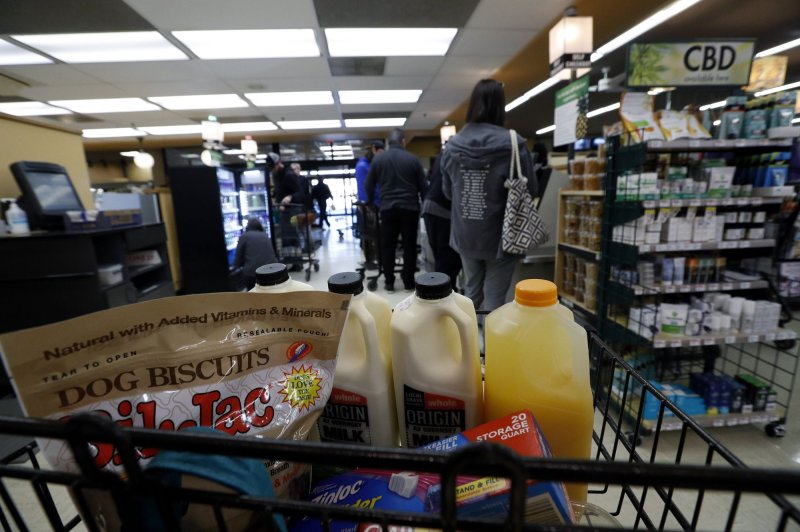By GILLIAN FLACCUS March 29, 2020

1 of 15
In this photo taken March 3, 2020, the Iron Gate Dam, powerhouse and spillway are on the lower Klamath River near Hornbrook, Calif. A plan to demolish four dams on California's second-largest river to benefit threatened salmon has sharpened a decades-old dispute over who has the biggest claim to the river's life-giving waters. The project, if it goes forward, would be the largest dam demolition project in U.S. history and would include the Iron Gate Dam facility pictured. (AP Photo/Gillian Flaccus)
KLAMATH, Calif. (AP) — The second-largest river in California has sustained Native American tribes with plentiful salmon for millennia, provided upstream farmers with irrigation water for generations and served as a haven for retirees who built dream homes along its banks.
With so many competing demands, the Klamath River has come to symbolize a larger struggle over the increasingly precious water resources of the U.S. West, and who has the biggest claim to them.
Now, plans to demolish four hydroelectric dams on the river’s lower reaches to save salmon — the largest such demolition project in U.S. history — have placed those competing interests in stark relief. Each group with a stake — tribes, farmers, ranchers, homeowners and conservationists — sees its identity in the Klamath and ties its future to the dams in deeply personal terms.
“We are saving salmon country, and we’re doing it through reclaiming the West,” said Amy Cordalis, a Yurok tribal attorney fighting for dam removal. “We are bringing the salmon home.”
The project, estimated at nearly $450 million, would reshape the Klamath River and empty giant reservoirs. It could also revive plummeting salmon populations by reopening hundreds of miles of potential habitat that has been blocked for more than a century, bringing relief to a half-dozen tribes spread across hundreds of miles in southern Oregon and northern California.

(AP)
The proposal fits into a trend toward dam demolition in the U.S. that’s been accelerating as these infrastructure projects age and become less economically viable. The removals are also popular with environmentalists who are fighting for the return of native fish species to rivers long blocked by concrete.
More than 1,700 dams have been dismantled around the U.S. since 2012, according to American Rivers, and the Klamath River project would be the largest by far if it proceeds.
Backers of the dam removal say the Federal Energy Regulatory Commission could vote this spring on whether to transfer the dams’ hydroelectric licenses from the current operator, PacifiCorp, to a nonprofit formed to oversee the demolition. Drawdown of the reservoirs behind the dams could begin as early as 2022, according the nonprofit, the Klamath River Renewal Corp.
Opponents, including a group of residents who live around a meandering lake formed by the oldest dam, have vowed to fight the project. Without the dam to create the reservoir, they say, their bucolic waterfront properties will become mudflats. Many say their homes have already lost half their value.
“If we get halfway through and they blow a hole in the dam just to let the water out — to say, ‘Yeah, we done this’ — they can walk away from it. And we have no recourse whatsoever,” said Herman Spannus, whose great-grandfather first ran a ranch in the area in 1856.
The structures at the center of the debate are the four southernmost dams in a string of six constructed in southern Oregon and far northern California beginning in 1918.
They were built solely for power generation. They are not used for irrigation, they are not managed for flood control, and none has “fish ladders,” concrete chutes fish can pass through.
Two dams to the north are not targeted for demolition. Those dams have fish passage and are part of a massive irrigation system that straddles the Oregon-California border and provides water to more than 300 square miles (777 square kilometers) of alfalfa, potatoes, barley and other crops.
Those farmers won’t be directly affected by the demolition but worry it will set a precedent that could eventually endanger the dams they rely on. An earlier, more comprehensive agreement would have given farmers a guaranteed annual minimum of water in exchange for the lower dams’ removal, but it fell apart in Congress. That leaves irrigators on the sidelines now during the most critical water-management decision for the larger Klamath River system in generations.
Farmer Ben DuVal said he’s optimistic the demolition will help restore salmon but also has “some real concerns.”

Farmer Ben DuVal; his wife, Erika, and their daughters, Hannah, 12, in purple, and Helena, 10, stand near a canal for collecting run-off water near their property in Tulelake, Calif. (AP Photo/Gillian Flaccus)
“Dam removal on this scale is kind of unprecedented,” said DuVal, who inherited his 300-acre (121-hectare) farm from his grandfather, a World War II veteran who won the land in a lottery in 1949. “I don’t want to be the one who ends up giving up my livelihood in order to fix a problem down there that was caused by a big experiment.”
The demolition plan is good business for PacifiCorp, which holds the dams’ hydroelectric license. The dams make up less than 2% of its overall power portfolio and are no longer an important part of the regional power picture due to new energy sources such as wind and solar and other factors, it says. In addition, the hydroelectric licenses have expired, and renewing them would require more than $400 million in federally mandated modifications.
Under the plan awaiting federal officials’ approval, $200 million for the demolition and river restoration will come from California and Oregon ratepayers, and $250 million will come from a voter-approved California water bond, with no liability for PacifiCorp and a guaranteed cap on its costs.
For the region’s tribes, however, the push to remove the dams is much more than financial calculus.
Salmon were once plentiful in the Klamath River, and the people who have lived alongside it for thousands of years have a powerful connection to the fish. Even now, with numbers of coho salmon and spring and fall chinook in free fall, tribal members name their children after the river and its fish, tattoo their bodies with elaborate images of fish hawks clutching salmon, and return to fishing holes that have been passed down through generations.

Georgiana Gensaw displays a tattoo of a fish hawk clutching a salmon that she got to honor her son, whose middle name is Ker-neet, the Yurok word for fish hawk, in Klamath, Calif. (AP Photo/Gillian Flaccus)
“I actually credit a lot of our men and women’s depression to the fact that they fish for days and days and days and days and don’t catch anything,” said Georgiana Gensaw, who is Yurok and lives on the reservation.
“We want to bring salmon home. We want to show off in front of our kids,” she said. “We want to show them how to do it and how to pass that on. And you can’t do that if there’s nothing in your net.”
Coho salmon from the Klamath River are listed as threatened under federal and California law, and their population in the river has fallen anywhere from 52% to 95%. Spring chinook, once the Klamath Basin’s largest run, has dwindled by 98%.
Fall chinook, the last to persist in any significant numbers, have been so meager in the past few years that the Yurok canceled fishing for the first time in the tribe’s memory. In 2017, they bought fish at a grocery store for their annual salmon festival.
Tribal members see a rejection of their entire way of life in the opposition to dam removal.
“It ain’t about how much they love those dams. It ain’t about that. It’s about Indians having any say or having any power or having anything kind of go our way (that) is a danger to American ideals. We’re supposed to be gone. We’re not supposed to be here,” said Chook-Chook Hillman, a Karuk Indian whose 10-year-old son wrote a rap song about damage to tribal traditions titled “Dry Your Eyes.”
But homeowners around the biggest reservoir, Copco Lake, say it’s not so simple — and they, too, feel a strong sense of place in the homes they built decades ago, with no idea the dams could ever come down and drain the man-made lake. Their property values have plunged.
“The real estate people are not anxious to take listings here because it’s the rumors there all the time,” said Tom Rickard, who had to take the retirement home he and his wife built 20 years ago off the market last summer when it didn’t sell.
“You hear people from Los Angeles, the Bay Area, all over the place, and they keep asking, ‘Well, what’s going to happen to the dams?’”
Other residents say removing the dams will mean losing an easily accessible water source for fighting wildfires. Voters in three counties who would be affected by dam removal voted against it in a non-binding question that demolition advocates say was an “opinion poll.”
“Does it really fix the fish equation just by removing the dams? I haven’t seen anything that tells me this is foolproof and we’re not going to have any problems,” said Siskiyou County Supervisor Michael Kobseff.
Even demolition advocates say dam removal, while critical, won’t be enough on its own to restore the salmon.

Demian Ebert, the Klamath program manager for PacifiCorp, looks at a tank holding juvenile chinook salmon being raised at a hatchery at the base of the Iron Gate Dam near Hornbrook, Calif. (AP Photo/Gillian Flaccus)
Salmon face deteriorating ocean conditions due to climate change, and the many tributaries that feed into the Klamath River — critical spawning habitat for returning salmon — are degraded. Some ranchers who graze cattle along those tributaries are working with environmentalists, but were stung when the earlier agreement among farmers, ranchers and tribes fell apart.
Dam removal “is such a small piece of the restoration of the entire basin,” said Becky Hyde, who runs a cattle ranch near Beatty, Oregon, with her husband.
“The pieces of what would bring stability to the entire basin and the agricultural community are gone — and we’re supposed to be cheerleading for dam removal,” she said. “This is not good enough.”











